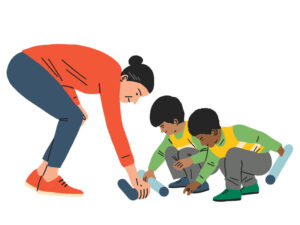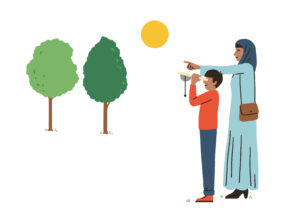Every single moment in our museums is an opportunity to engage and shape visitors’ attitudes towards science, technology, engineering and maths (STEM) – from the website, the front desk, the people they meet, to the cafés and galleries. What the research into science capital has done, is brought into focus the opportunities that we all have for further development and refinement of our practice to be as welcoming and open for as wide an audience as possible, that we don’t perpetuate the association that science is for some people – but not for everyone.
Reflective practice
As science communicators and cultural practitioners we instinctively recognised the best practice that the science capital principles encourage. As such, we see that reflective practice is the central principle for us to apply science capital to our work to help us to critically think about our visitors’ experience with us, from the environment that we invite our visitors into, to the feelings and emotions they will take from our experiences.
So, to support and empower all our staff to do this, we wanted to create something that could be used everyday and would speak to the broad range of work that we do in our museums. Following trials of a few ideas based on the source research, we created a set of reflection points which have been informed by the 8 dimensions of science capital and wider science engagement best practice. They are also founded on our Science Museum Group approach and values and saw that we could easily apply to our day to day work.
We have piloted these reflection points with different teams across our museums and feedback so far has been really positive, with staff reporting that they feel inspired and motivated to critically reflect on their everyday practice. We will be sharing examples of how we have been using these refection points in our everyday work in future posts (click on each reflection point below).
THE THEORY OF CHANGE

Our science engagement reflection points
Language (verbal and visual) – ‘…do I see science as something I am part of?’
The language and communication that we use to help everyone feel welcome in our spaces, and to feel that they can do and be part of science.
- How do we use language and imagery to make everyone feel included in science – and not make it feel like the ‘possession’ of others (of scientists or the museum)?
- Use personal pronouns – you, we, your, our etc. and use gender neutral visual and verbal language and messages.
- Explain any science or museum ‘jargon’. Not all visitors will understand our common terminology such as ‘interactive, objects, labels etc.’
STEM content knowledge – ‘….do I understand this science?’
How we value and build on people’s existing STEM knowledge and experiences.
- How do we value and build on people’s existing STEM knowledge and experiences?
- Don’t start with an assumed level of knowledge, new information should feel like a natural extension of what people already know.
- Broaden people’s ideas of what counts as science and communicate how science works, how it is more than knowledge; it is a way of thinking, working and being curious about the world around us.
Skills – ‘…what skills do I already have and use?’
How we can help visitors to recognise that they have and use science skills, and see where they are transferable to other parts of their life.
parts of their life.
- Let people know what science skills they are using in the activities/ experiences and help them to recognize that they have these skills.
- Give examples of where and how these skills are used in daily life and show how those science skills are useful in their interests, work and are useful for many jobs.
Use everyday examples –‘…what does it look like when I bump into science?’
How our content and experiences connects and relates to our visitors’ rich and diverse interests, experiences and everyday lives.
- Don’t make assumptions of what people’s interests and experiences are. Everyone is different (and may not have have the same experiences and interests as you). Where possible ask what visitors care about and help them to connect to that.
- Show examples of where and how science has useful applications in our everyday lives and can help solve real life issues.
- Reference things visitors might know about and can easily link and connect to make the experience more relevant and meaningful.
- Show collections/ interactive activities where possible in context, showing where and how it ‘fits’ into everyday life.
People – ‘…are there people I relate to represented here?’
How we show the ‘everyday’ people who are involved in science.
- How do we represent all the different people who work, use or benefit from science?
- Widen perceptions of who does science –how science isn’t just for scientists. Show diverse examples of people who use science in their work to help visitors to recognise people they know who do science.
- Reference how scientific progress is shaped by the users as well as ‘scientists’ and how science is not a solo pursuit but involves teams of people.
- Link historical scientists to contemporary people in similar fields.
Confidence and ownership –‘…is this a place for me?’
How we help make everyone feel welcome and confident to take part in our experiences and feel that our museums are a place for them.
- Make everyone feel welcome and confident to contribute in activities/ experiences.
- How we help visitors understand what they can expect from our experiences.
- Give everyone a role in the experience (both adults and children) and opportunities to share their knowledge and experiences together.
- Invite them to follow their interests and give them choice and control in activities.
Promote talk – …what might we talk about?
How we help visitors to talk and share their own stories and opinions about science.
- Provide questions to get people thinking and talking about the science they have experienced and to help make connections to their own lives.
- Invite people to share their own stories/experiences and give ideas that will help generate conversation between families, peers, community – both in the museum, home or at school.
Extend the experience – …how can I continue this experience or find out more?
How we extend our experiences, in and beyond our museums.
- Help people to continue making science connections in other places in the museum, and in their everyday lives (home, school etc.) – leave no dead ends.
- Make the experience last longer by giving people simple ideas and activities to do after they leave the museum (e.g. trying out a kitchen science experiment, things to notice on the way home or to school, questions to think about or to research further)
- Leave no dead ends – provide ways for visitors to find out more if they want or need to on their own terms.
Positive reinforcement –…am I a science-y person, is science something that people believe that I can do well?
How we help visitors to leave with the feeling ‘I can do that’, I am a science-y person.
- Build confidence by rewarding science knowledge, behaviour and skills. Tell people they are being scientific, thinking like an engineer etc.
- Leave them with the feeling that ‘I can do that’ and ‘I want to find out or do more’.